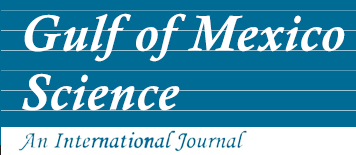Alternate Title
Episodic Rainfall Influences the Distribution and Abundance of the Regular Sea Urchin Lytechinus variegatus in Saint Andrew Bay, Northern Gulf of Mexico
Abstract
The distribution and abundance of Lytechinus variegatus (Lamarck) were determined at three shallow-water stations in Saint Andrew Bay, FL, in the northern Gulf of Mexico. Populations were monitored at 4-mo intervals from Aug. 1997 to Aug. 1999 along 2- X 10-m transects, with four transects at each station. In Aug. 1997 individuals ranged in size from 15- to 63-mm diameter (mean = 38 mm; density= 1.4 individuals (ind.) m-2) at Station 1 (Stations 2 and 3 were not sampled on that date). By Oct. 1997 individuals at Station 1 ranged in size from 26 to 62 mm (mean = 48 mm; density = 0.6 ind. m-2), suggesting the growth of individuals within the population. At Station 2, individuals ranged between 50 and 70 mm (mean = 59 mm; densities = 1.0 ind. m-2) and at Station 3 between 30 and 79 mm (mean= 51 mm; densities = 1.4 ind, m-2) in Oct. 1997, indicating a population with no recent recruits. A mass mortality event was observed in April 1998 and was attributed to reduced salinities resulting from above-average rainfall in the previous month. Sea urchins were absent at Stations 1 and 2, whereas at Station 3 postdisturbance recruits were smaller (mean = 28 mm) and densities lower. Sea urchin tests were also observed at beach stations proximate to Stations 1 and 2. By July 1998 the populations had partially recovered at Stations 2 and 3 (densities = 0.6 and 1.1 ind. m-2, respectively), but test diameters were small at both stations. Test diameters had increased in Dec. 1998 at Station 3 when compared with those of July, but individuals at Station 2 showed overall smaller test diameters (mean = 28 mm), and densities had decreased again, presumably after another mass mortality caused by another major rainfall in Sep. In April 1999 test diameters had decreased further at Stations 2 and 3, indicating emigration or death of larger animals. We suggest that the shallow-water Saint Andrew Bay population of L. variegatus is reduced for several years at a time by episodic heavy rainfalls. This observation emphasizes the importance of density-independent processes controlling the distribution and abundance of marine organisms.
Recommended Citation
Böttger, S., L. E. Thompson, S. A. Watts, J. B. McClintock and J. M. Lawrence.
2002.
Episodic Rainfall Influences the Distribution and Abundance of the Regular Sea Urchin Lytechinus variegatus in Saint Andrew Bay, Northern Gulf of Mexico.
Gulf of Mexico Science
20
(1).
Retrieved from https://aquila.usm.edu/goms/vol20/iss1/7

